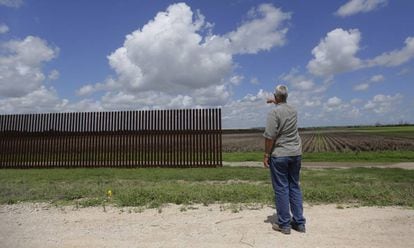Trump’s team looks into viability of his wall with Mexico
Border officials suggest a fence is better option, and only along some stretches
One of the oft-repeated pledges Donald Trump made during the recent US presidential election campaign was to build a “big, beautiful wall” along the border with Mexico to keep “rapists” and “drug addicts” out, and that furthermore, the United States’ southern neighbor would pay for.

Now, less than a month away from taking office, Trump seems to have begun looking into whether he will be able to keep his promise to voters. The President-elect’s team has contacted border officials in Texas, who have said that any barrier should be a fence, not a wall, and that it would only be needed in certain areas.
Henry Cuellar, a Democrat Congressman for Texas whose district includes some 320 kilometers of border with Mexico, opposes Trump’s plans, and has also spoken to border officials.
“If there were to be a fence, [border officials] would want it to be limited and to apply only to certain areas,” the Congressman told EL PAÍS by telephone. “I am sure that no senior official along the border is recommending that their sector be 100% covered by a fence,” he added.
A mile of fence costs around $6.5 million; surveillance technology costs $1 million
The border between the United States and Mexico runs for 3,100 kms. Of this, some 1,000 are already fenced as a result of legislation passed in 2006. In Texas, the border runs for 2,000 kms, of which just 160 are protected by a fence, according to the Associated Press. The rest of the frontier is made up of geographical obstacles such as mountains or the Rio Grande river.
“Build the wall!” was one of the most popular chants at Trump campaign meetings. But in his first television interview after winning the elections on November 8, Trump admitted that a fence was a more likely option and refused to give more details. In the video in which he announced the agenda for his first 100 days in office, there was also no mention of any wall with Mexico.
Nevertheless, since November 8, Trump’s team has said repeatedly that building a wall is a priority for the incoming president. Their contacts with border officials would suggest this remains the case, but also indicate that for those on the ground, Trump’s plans are not seen as the best solution.
Around a third of the 3,100 km border is already fenced
Furthermore, Cuellar points out that any further fence building would require Congressional approval. The Republican Party, which controls both houses, argues in favour of beefing up border security, but legislators too have also suggested that they are not necessarily in favour of any hypothetical wall.
For the Democratic Party, opposition to any wall is a matter of principle. “A fence is a 14th century solution to a 21st century problem,” says Cuellar, adding that anyway, around 40% of undocumented migrants in the United States arrived legally and that a wall would not put a brake on asylum requests.
Another factor is geography. Laredo, with a population of 255,000 inhabitants, is the most important city in Cuellar’s district. The only physical barrier there is a fence along a small stretch of the border. What really separates Laredo from Nuevo Laredo on the other side of the frontier with the state of Tamaulipas is the Rio Grande. Cuellar says that there are many areas along the river where it would not be possible to build any kind of barrier, in large part because the Republican governor of Texas has made it clear protected parkland would make it impossible.
There are also economic issues. Cuellar says that a mile of fence costs around $6.5 million, while simply using technology to increase surveillance of border areas costs around $1 million per mile.
English version by Nick Lyne.












































